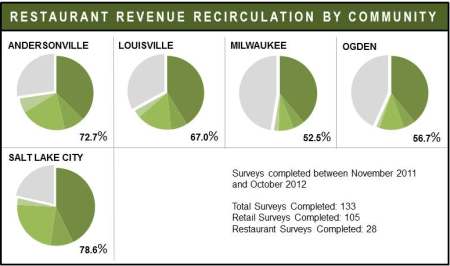Four New Economic Studies Find Indies Have a Bigger Impact
- By David Grogan
Recently released studies focusing on the economic impact of indies in four different areas of the country have reached the same conclusion: Independent businesses return far more of their revenue to their local communities than do chains. In the four communities, indie retailers returned a total of at least 44 percent of all revenue back to their local economies.
The studies — which looked at the impact of indie retailers and restaurants in Louisville, Kentucky; Milwaukee, Wisconsin; Ogden, Utah; and the Six Corners area of Chicago — were the final phase in the Indie Impact Study Series, a nationwide research project conducted by Civic Economics in partnership with the American Booksellers Association. The project, which launched last fall, enabled communities with active ABA members to engage directly with Civic Economics for a customized local study for a significantly reduced fee. Ten studies were conducted and each was sponsored the community’s local first associations and/or booksellers in each of the locations.
“With 10 localized surveys of independent business completed, the findings are consistent with previous studies and among participating communities,” said Dan Houston of Civic Economics. “In big cities and small towns and from coast to coast, independents produce strong local economic returns compared to their chain competitors. Everywhere we’ve looked, we as consumers have the opportunity to make a big difference in our local economies with small changes in our habits.”

The Louisville study sponsored by the Louisville Independent Business Alliance (LIBA) and Carmichael‘s Bookstore looked at 17 retailers and three restaurants, all independent and locally owned. Collectively, these retailers recirculate a total of 55.2 percent of all revenue to the local economy: 27.5 percent in profit and labor; 6.4 percent for internal use; 16.4 percent for the procurement for resale; and 4.9 percent in charitable giving.
The Louisville study concluded that “a market shift of just 10 percent from chains to independents would retain an additional $416 million in the regional economy every year.”
“I frequently used data from the Austin, Andersonville, or Grand Rapids studies when speaking to groups or the press, but now that we are able to quote results based directly on data from our own community, I expect the ‘Buy Local’ message to have even greater resonance in Louisville,” said Carol Besse, co-owner of Carmichael’s Bookstores and LIBA secretary. “It should be hard for anyone to ignore a figure like $416 million…. Carmichael’s is grateful to the ABA for subsidizing this study — it’s another example of how they supporting indie booksellers across the country.”
In Milwaukee, the study looked at seven retailers and three restaurants, all independent and locally owned. Collectively, these retailers return a total of 44.1 percent of all revenue to the local economy, the study found. It also noted that a market shift of just 10 percent from chains to indies would keep an additional $311 million in the regional economy every year. The Milwaukee study was sponsored by Local First Milwaukee and Boswell Book Company.
Similarly, in the Ogden study sponsored by Buy Local First Ogden, six retailers and seven restaurants, all locally owned and independent, recirculated just over 48 percent of all revenue back to the local economy. “A market shift of just 10 percent from chains to independents would retain an additional $121 million in the regional economy every year,” the study concluded.
And in Six Corners, Chicago, the study surveyed six retailers, all independent and locally owned, and found that these retailers return a total of nearly 71 percent of all revenue to the local economy. The Six Corners study was sponsored by the Six Corners Association and City Newsstand. A 10 percent market shift in Six Corners, the study estimated, would retain an additional $2 billion in the regional economy every year.


